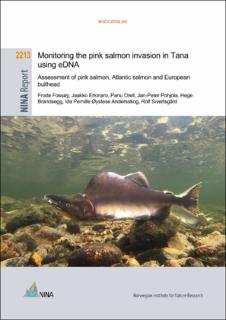| dc.description.abstract | Fossøy, F., Erkinaro, J., Orell, P., Pohjola, J.-P., Brandsegg, H., Andersskog, I.P.Ø. & Sivertsgård, R. 2022. Monitoring the pink salmon invasion in Tana using eDNA. Assessment of pink salmon, Atlantic salmon and European bullhead. NINA Report 2213. Norwegian Institute for Nature Research.
Human introduction of non-native species is a major threat to biodiversity, and early detection is crucial for implementing conservation mitigations. The pink salmon (Oncorhynchus gorbuscha) is originally native to rivers draining to the Pacific ocean, but reports on occurrence of pink salmon in Norway have increased sharply in recent years. Pink salmon is an anadromous species with a two-year life cycle where both males and females die after spawning. In Norway, the odd-year spawners are dominating with large numbers of fish recorded in 2017, 2019 and 2021. Monitoring presence and abundance of pink salmon is crucial for implementing possible mitigation efforts. Analyses of environmental DNA (eDNA) is a new cost-efficient method for detecting rare and invasive species. Here we report the results from eDNA analyses of the river Tana, including 19 localities in 2019 and 24 localities in 2021. The Tana watercourse constitutes the border between northern Finland and Norway and is supporting the largest Atlantic salmon population in Norway. The eDNA analyses detected Atlantic salmon (Salmo salar) in almost all tributaries in both years, with a pronounced higher DNA-concentration in the middle of the watercourse. In 2019, we detected pink salmon in four different tributaries, representing more or less all parts of the watercourse. In 2021, we detected pink salmon in 15 localities, with somewhat higher DNA-concentrations than in 2019, reflecting the observed increase in pink salmon numbers. The eDNA analyses also included another alien species in the Tana system, the European bullhead (Cottus gobio), where detections were constrained to the lower parts of Tana. We conclude that analysis of eDNA water samples is a cost-efficient method for monitoring the invasion of pink salmon at many localities, with the potential of including analyses of multiple species. We recommend that future monitoring implements a standard design with resampling of the same localities at the same time each year to enable inference on long-term trends in eDNA-concen-trations. | en_US |
